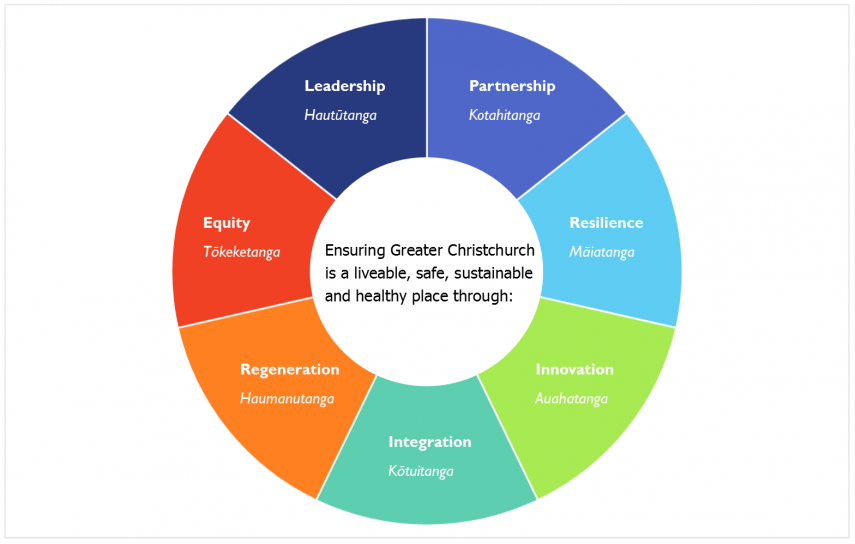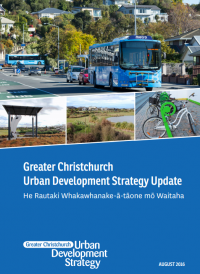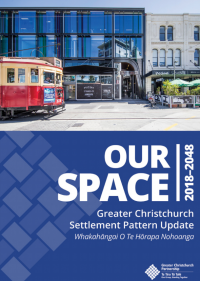The vision for Greater Christchurch
By the year 2041, Greater Christchurch has a vibrant inner city and suburban centres surrounded by thriving rural communities and towns, connected by efficient and sustainable infrastructure.
There are a wealth of public spaces ranging from bustling inner city streets to expansive open spaces and parks, which embrace natural systems, landscapes and heritage.
Innovative businesses are welcome and can thrive supported by a wide range of attractive facilities and opportunities.
Prosperous communities can enjoy a variety of lifestyles in good health and safety, enriched by the diversity of cultures and the beautiful environment of Greater Christchurch.
Guiding principles
These strategy principles are from the UDS Update 2016 and have slightly modified those contained in the 2007 Strategy.
 Ensuring Greater Christchurch is a liveable, safe sustainable and healthy place through:
Ensuring Greater Christchurch is a liveable, safe sustainable and healthy place through:
- Leadership - Hautūtanga
- Partnership - Kotahitanga
- Resilience - Māiatanga
- Innovation - Auahatanga
- Integration - Kōtuitanga
- Regeneration - Haumanutanga
- Equity - Tōkeketanga
These Principles underpin and provide context for the strategy. They shape and guide decision-making and implementation.
Strategic goals
The Strategic goals [PDF, 221 KB] outline the outcomes the strategy seeks to achieve, and provide the basis for the specific actions and work programmes.
The Strategic goals [PDF, 221 KB] are grouped under the themes of:
- Healthy communities
- Enhanced natural environments
- Prosperous economies
- Integrated and managed urban development.
The strategic goals are from the UDS update 2016 and amend and update the strategic directions in 2007 strategy.
The Urban Development Strategy 2007
The strategy provides a broad settlement pattern for Greater Christchurch over 35 years, including:
- Identifying where a variety of future homes, such as central city apartments, town houses and family-sized houses, are best located
- Providing a living environment that supports healthy communities
- Ensuring residents have easy access to shopping, health, education and community services
- Providing a range of transport choices, including public transport, cycling and walking
- Developing new and expanding existing business centres and employment areas
- Ensuring these areas are well connected to wider road and rail networks.
The Strategy encourages Strategy Partners, communities, business, Central Government and non-government agencies to work collaboratively in managing growth to conserve or enhance precious resources and environments, while allowing growth to build vibrant and prosperous towns and suburbs that help support a growing healthy city.
Greater Christchurch Urban Development Strategy 2007 [PDF, 3.5 MB]
Greater Christchurch Urban Development Strategy (Summary) 2008 [PDF, 665 KB]
Our Space 2018-2048
The Partnership has undertaken a review of the strategic land use planning framework for Greater Christchurch.
Our Space 2018-2048: Greater Christchurch Settlement Pattern Update [PDF, 6.4 MB] outlines land use and development proposals to ensure there is sufficient development capacity for housing and business growth across Greater Christchurch to 2048.
It complements the existing Greater Christchurch Urban Development Strategy (UDS) [PDF, 3.5 MB] and has been prepared in order to satisfy the requirement to produce a future development strategy, outlined in the National Policy Statement on Urban Development Capacity.
The Greater Christchurch Partnership Committee meeting on 14 June 2019 endorsed the final Hearing Panel report [PDF, 3.8 MB] and its recommended changes to Our Space, thereby endorsing the Our Space settlement pattern update as the future development strategy for Greater Christchurch.
Subsequent ratification at meetings of each partner local authority occurred during June and July also adopted Our Space.
Further information on the background and development of Our Space 2018-2048.
 Urban Development Strategy Update 2016
Urban Development Strategy Update 2016
After the upheaval and recovery of the last few years, an update of the Greater Christchurch Urban Development Strategy has been completed.
The updated Strategy focuses on people - both those already living in Greater Christchurch, and the generations to come - and their social, cultural, economic and environmental wellbeing. It draws on recent strategic work and consultation, and integrates associated resilience work.
The updated Strategy guides the work of the UDS Partnership until a more thorough review of the UDS is undertaken, within the next few years.
Action plan
In 2010 the detailed Action Plan within the 2007 Strategy was reviewed to ensure that it was up-to-date, consistent with council strategies and changing legislation, and reflected significant developments since 2007.
It also made changes where actions had been completed, to provide better clarity of direction, and to allow greater flexibility regarding the mechanism of how actions might best be delivered.
A further review in light of the Canterbury earthquakes of 2010 and 2011 identified which actions were considered to be priorities for incorporation within the development of recovery plans and programmes.
The UDS Update 2016 drew from this previous implementation work to identify eleven priority actions.
- Strategy Update 2016 - Priority Actions [PDF, 7.6 MB] contained in section 5 of the Strategy Update document
- Updated Action Plan 2010 [PDF, 1.1 MB]
- Action Plan 2007 [PDF, 3.5 MB] contained within each chapter of the main Strategy document

